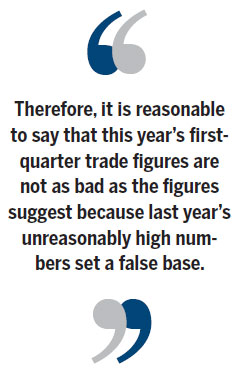The truth behind trade figures
Updated: 2014-04-18 07:53
By Luo Jiexin and Xu He (China Daily Europe)
|
|||||||||||
Several factors led to the decline in first-quarter trade figures, but there is no cause for concern
China's foreign trade did not do well in the first quarter of this year, at least according to the raw statistics.
In renminbi terms, exports declined 6.1 percent year-on-year from the January-March period, while imports fell 1.2 percent. The double decreases resulted in an overall trade drop of 3.7 percent. This is the first time since last June that all three indicators have fallen.
But the real picture is not as bleak as the data suggested. Instead, China's foreign trade remained stable, if not robust, in the first quarter, after the fake-trade effect was taken out.
This year's trade figures reflect the true picture, while last year's were inflated by hot money flows under the guise of trade activities.
There is evidence that confirms this trend.
First, the mainland's trade with Hong Kong declined one-third in the first quarter. The sharp decline was in stark contrast to 60 percent growth from January to March 2013. Hong Kong traditionally serves as a proxy for money flows between the mainland and the rest of the world. Accordingly, foreign trade in Hong Kong's neighbor, Guangdong province, also fell noticeably this year. Clearly, unlike a year ago, hot money flows this year have been largely curbed.
Second, trade in some goods, such as jewelry and high-tech products, decreased sharply in the first quarter. Money movers involved in over-invoicing favor these products because they are small and valuable. For example, trade in integrated circuits jumped about 40 percent in the first quarter last year, but it declined more than 30 percent in the first quarter this year. The change showed that over-invoicing last year had been corrected.

Third, unexpected depreciation of the yuan since February narrowed the rate gap between offshore and onshore markets, effectively putting hot money flows under control.
Therefore, it is reasonable to say that this year's first-quarter trade figures are not as bad as the figures suggest because last year's unreasonably high numbers set a false base.
After excluding trade with Hong Kong and particular categories of products, China's foreign trade in the first quarter of this year may have grown by between 6 to 8 percent. This would represent stable growth and a solid start for the country to achieve its goal of 7.5 percent growth in trade this year.
In addition, if price factors are considered, the first-quarter performance was not as sluggish as the figures superficially suggest. Trade volumes of some goods, especially commodities such as copper, increased strongly. But due to a price fall, the value of the trade did not increase as much as it might have. With imports of raw materials increasing, exports are expected to grow in the second and third quarters.
Also, foreign trade figures will brighten in the second quarter because fake trade was squeezed out in the second quarter last year. This should provide a smaller base to compare this year's figures.
Other good news included continued recovery of major world economies such as the United States and Europe and a stable number of buyers registered at China's largest trade fair.
The spring edition of the 115th China Import and Export Fair, also known as the Canton Fair, attracted about 200,000 international buyers.
The event opened on April 15 and serves as a barometer of China's trade.
Experience shows that if the number of foreign buyers at the fair is close to 200,000, it means global demand for Chinese goods, especially low to medium-end products, will remain stable, if not robust.
In that sense, there is no cause for pessimism over China's trade prospects, and net exports may contribute a small portion of GDP growth this year.
The authors are Shanghai-based financial analysts. The views do not necessarily reflect those of China Daily.
(China Daily European Weekly 04/18/2014 page12)
Today's Top News
EU hopes to strengthen climate co-op with China
64 dead in Korean ferry sinking
Nuclear plants to get the nod
No naval meet with Japan
Putin makes overture to incoming NATO chief
China on frontlines of cyber threat
China raises alert against cancer
William, Kate visit Australian air force base
Hot Topics
Lunar probe , China growth forecasts, Emission rules get tougher, China seen through 'colored lens', International board,
Editor's Picks

|

|

|

|

|

|





